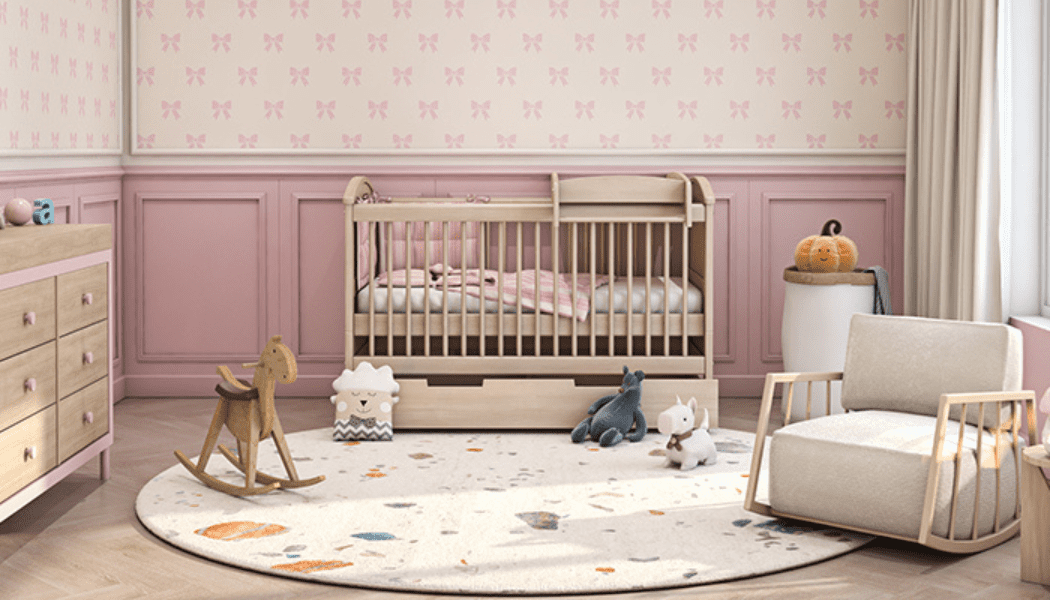Nursery Rugs | Guide to Creating Safe, Beautiful Spaces for Your Little One

Introduction
Creating a nursery is one of the most meaningful projects expectant parents undertake. Every element matters—from the crib and changing table to the wall colors and lighting. Among these important decisions, selecting the perfect *nursery rugs* deserves special attention. These floor coverings do far more than simply complete your room's aesthetic; they provide cushioning for developing bodies, create comfortable play spaces, dampen sound, and establish the warm, nurturing atmosphere every baby deserves. Understanding how to choose nursery rugs that balance safety, functionality, and beauty ensures your little one's first room becomes a space where memories are made and comfort reigns.
Why Nursery Rugs Are Essential for Baby
Beyond their obvious decorative appeal, nursery rugs serve critical functional purposes that directly impact your baby's safety, comfort, and developmental environment.
Safety and Protection
Babies spend significant time on floors during tummy time, learning to crawl, taking first steps, and playing with toys. Hard flooring provides no forgiveness when inevitable tumbles occur. A properly selected nursery rug creates a cushioned surface that softens falls, protecting delicate heads and bodies during these crucial developmental stages.
This cushioning becomes particularly important around cribs and changing tables. Babies have been known to roll off changing surfaces despite vigilant supervision, and a soft rug beneath can reduce injury severity. Similarly, as babies begin pulling themselves up using crib rails, they frequently lose balance and sit down hard. A padded floor surface makes these learning experiences less jarring.
Sound Reduction
Nurseries generate surprising amounts of noise—crying, musical toys, parents walking during night feedings, and general activity. *Nursery room rugs* absorb sound effectively, reducing both the noise traveling from the nursery to other areas of your home and the echo within the room itself. This sound reduction creates calmer environments conducive to sleep and peaceful play.
For homes with downstairs neighbors or multiple children sharing walls, this acoustic benefit becomes even more valuable. A quality rug significantly reduces impact noise from dropped toys, stomping toddler feet, and general activity that might otherwise disturb others.
Thermal Comfort
Tile, hardwood, and laminate flooring feel cold, especially during winter months or in homes with minimal heating. Babies who play on cold floors experience discomfort that can shorten play sessions and reduce their willingness to practice important motor skills. Rugs provide insulation that keeps floors warmer and more inviting, encouraging longer, more productive play periods.
Understanding Rug Sizes for Nursery
Selecting appropriately sized nursery rugs significantly impacts both functionality and aesthetics. Understanding standard area rug sizes and how they relate to typical nursery dimensions helps you make informed decisions.
Standard Room Dimensions
Most nurseries range from 10x10 feet (small) to 12x12 feet (medium) to 14x16 feet (spacious). Understanding your room's dimensions provides the foundation for appropriate rug selection. Measure your nursery carefully before shopping, noting not just overall dimensions but also furniture placement and door swing paths.
Common Rug Sizes
Area rug sizes come in standard increments, each suited to different applications and room sizes:
Small area rugs (3x5, 4x6 feet) work as accent pieces beneath cribs, in front of changing tables, or as dedicated play mats in corners. These sizes offer targeted functionality without dominating small spaces.
Medium rugs (5x7, 5x8 feet) suit most standard nurseries beautifully, providing substantial coverage that anchors the room's center while leaving appropriate floor borders visible.
Large rugs (8x10, 9x12 feet) work best in spacious nurseries or open-concept spaces where the nursery area connects to other rooms. These sizes can accommodate multiple furniture pieces while creating cohesive, well-defined spaces.
Targeted Functionality
Small area rugs excel at providing functionality exactly where needed. A compact rug at the changing table protects the flooring from inevitable spills and provides cushioning if you lean against the table during extended diaper changes. Near the closet door, a small rug catches dirt before it spreads throughout the room. These targeted placements let you address specific needs without committing to large, expensive pieces. As your child's needs evolve, small rugs move easily to new locations or different rooms, offering flexibility that permanent floor coverings cannot match.
Budget Conscious
Quality small area rugs typically cost significantly less than larger options, making them attractive for budget-conscious parents. You can afford higher-quality materials and construction in smaller sizes than you might manage for room-sized pieces. This approach prioritizes quality over quantity—a well-made small wool rug often outperforms a large, cheap synthetic alternative.
Multiple small rugs also spread costs over time. Start with one or two pieces for essential areas, then add others as budget allows. This phased approach prevents overwhelming initial expenses while building a cohesive nursery design gradually.
Natural Options
Cotton ranks among the most popular nursery rug materials for good reason. It's naturally hypoallergenic, machine washable (in appropriate sizes), soft yet durable, and available across all price points. Cotton rugs handle frequent cleaning well—essential in nurseries where spills, spit-up, and diaper accidents occur regularly.
Wool offers natural stain resistance, fire resistance without chemical treatments, exceptional durability, and beautiful texture. While pricier than cotton, wool rugs last through multiple children with proper care. The fiber naturally repels moisture and resists crushing, maintaining appearance despite heavy use.
Jute and sisal provide eco-friendly options with appealing natural textures. These work beautifully as base layers in layered rug designs, though their rougher textures make them less suitable as primary play surfaces. They're best reserved for under-crib areas or beneath furniture rather than play zones.
Synthetic Materials
Polypropylene offers remarkable stain resistance, easy cleaning, affordability, and surprising durability. Modern polypropylene rugs look and feel substantially better than earlier versions, making them practical choices for budget-conscious parents prioritizing easy maintenance.
Nylon provides exceptional resilience, bounce-back from crushing, and vibrant color retention. It costs more than polypropylene but less than natural fibers, occupying a middle ground that appeals to many families.
Quality Nursery Rugs
When creating your baby's nursery, quality matters immensely—not just for aesthetics but for safety and durability through years of intensive use. Weave NYC has established itself as a trusted destination for parents seeking nursery rugs that meet the highest standards while offering beautiful designs that complement any décor vision.
What sets Weave NYC apart is its thoughtful curation, specifically addressing families' needs. Their nursery rug collection emphasizes safety features like low-VOC materials, appropriate pile heights, and non-slip characteristics while never compromising on design appeal. Whether you're seeking whimsical patterns that stimulate infant development, sophisticated neutrals that grow with your child, or practical materials that withstand inevitable messes, their inventory offers options across styles and budgets.
The expertise available through Weave NYC proves invaluable during the nursery planning process. Their team understands the unique requirements of these special spaces and can guide you toward selections that balance your aesthetic preferences with practical considerations like washability, durability, and material safety. They offer clear information about fiber content, construction methods, and care requirements, empowering informed decisions.
Beyond product quality, Weave NYC commitment to customer satisfaction includes helpful sizing guidance, accurate product photography that represents true colors and textures, and responsive support if questions arise. For parents navigating the overwhelming array of nursery preparation tasks, having a reliable partner for this important purchase provides welcome peace of mind. When you're ready to select nursery rugs that combine beauty, safety, and lasting quality, Weavenyv.com deserves your careful consideration.
Maintenance
Nursery rugs endure remarkable wear—spit-up, diaper leaks, spilled bottles, dropped food, and general dirt. Understanding proper care ensures they remain hygienic and attractive.
Vacuum nursery rugs at least twice weekly, more often if your baby spends significant floor time. Use appropriate settings for your rug's construction—gentle suction for delicate materials, standard settings for durable synthetics. Regular vacuuming prevents dirt from embedding in fibers, where it causes premature wear. Rotate rugs every few months to ensure even wear patterns and sun exposure. This simple practice dramatically extends lifespan, particularly important for pieces seeing intensive daily use.
Cleaning Techniques
Act immediately when spills or accidents occur. Blot liquids with clean cloths—never rub, which spreads stains and damages fibers. For organic spills (spit up, formula, baby food), enzyme-based cleaners designed for protein stains work effectively without harsh chemicals inappropriate for nursery environments. Keep appropriate cleaning supplies readily accessible in your nursery; you won't always have time to hunt for products when accidents happen. White cloths prevent color transfer, and gentle, baby-safe cleaners ensure you're not introducing harsh chemicals to your baby's environment.
Specific Nursery Challenges
Diaper accidents require special attention. Remove solid matter carefully, then treat the area with enzyme cleaners specifically designed for biological stains. Multiple treatments may be necessary for complete odor and stain removal. Spit-up and formula typically respond well to prompt blotting followed by gentle cleaning with mild soap and water. Don't let these protein-based stains sit—they set quickly and become difficult to remove.
Conclusion
Selecting the ideal nursery rugs represents an important investment in your child's safety, comfort, and developmental environment. Whether you choose a versatile 3x5 rug for targeted applications, a generously sized 5x8 rug for comprehensive coverage, or strategic combinations of small area rugs that address specific needs, thoughtful selection ensures your nursery becomes a space where your baby thrives.
Remember that the best nursery rug balances multiple considerations: safety features that protect your precious little one, materials that withstand inevitable messes while remaining easy to clean, cushioning that supports developmental milestones, and designs that create the nurturing atmosphere every child deserves. Understanding standard area rug sizes and how they relate to your specific nursery dimensions empowers confident decision-making that serves your family well.
As you navigate the exciting journey of creating your baby's first room, let nursery room rugs provide the foundation literally and figuratively for countless precious moments. From late-night feedings to first crawls, from quiet story times to energetic play sessions, the rug you choose witnesses and supports these irreplaceable experiences. Invest thoughtfully, prioritize safety and quality, and create a space where love, learning, and beautiful memories flourish for years to come.






